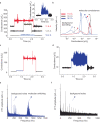Controlling piezoresistance in single molecules through the isomerisation of bullvalenes
- PMID: 37789027
- PMCID: PMC10547723
- DOI: 10.1038/s41467-023-41674-z
Controlling piezoresistance in single molecules through the isomerisation of bullvalenes
Abstract
Nanoscale electro-mechanical systems (NEMS) displaying piezoresistance offer unique measurement opportunities at the sub-cellular level, in detectors and sensors, and in emerging generations of integrated electronic devices. Here, we show a single-molecule NEMS piezoresistor that operates utilising constitutional and conformational isomerisation of individual diaryl-bullvalene molecules and can be switched at 850 Hz. Observations are made using scanning tunnelling microscopy break junction (STMBJ) techniques to characterise piezoresistance, combined with blinking (current-time) experiments that follow single-molecule reactions in real time. A kinetic Monte Carlo methodology (KMC) is developed to simulate isomerisation on the experimental timescale, parameterised using density-functional theory (DFT) combined with non-equilibrium Green's function (NEGF) calculations. Results indicate that piezoresistance is controlled by both constitutional and conformational isomerisation, occurring at rates that are either fast (equilibrium) or slow (non-equilibrium) compared to the experimental timescale. Two different types of STMBJ traces are observed, one typical of traditional experiments that are interpreted in terms of intramolecular isomerisation occurring on stable tipped-shaped metal-contact junctions, and another attributed to arise from junction‒interface restructuring induced by bullvalene isomerisation.
© 2023. Springer Nature Limited.
Conflict of interest statement
The authors declare no competing interests.
Figures








References
-
- Aragonès AC, et al. Electrostatic catalysis of a Diels–Alder reaction. Nature. 2016;531:88–91. - PubMed
-
- Gu C, et al. Label-free dynamic detection of single-molecule nucleophilic-substitution reactions. Nano Lett. 2018;18:4156–4162. - PubMed
-
- Tang C, et al. Identifying the conformational isomers of single-molecule cyclohexane at room temperature. Chem. 2020;6:2770–2781.
-
- Yang, C., et al. Unveiling the full reaction path of the Suzuki–Miyaura cross-coupling in a single-molecule junction. Nat. Nanotechnol. 16 1214–1223 (2021). - PubMed
LinkOut - more resources
Full Text Sources

